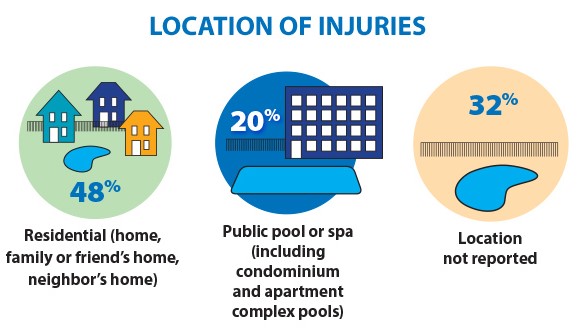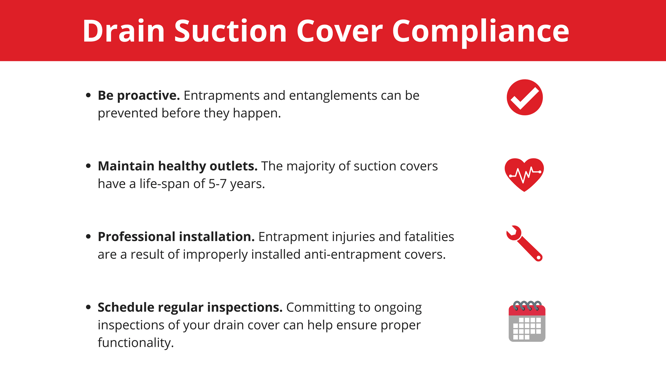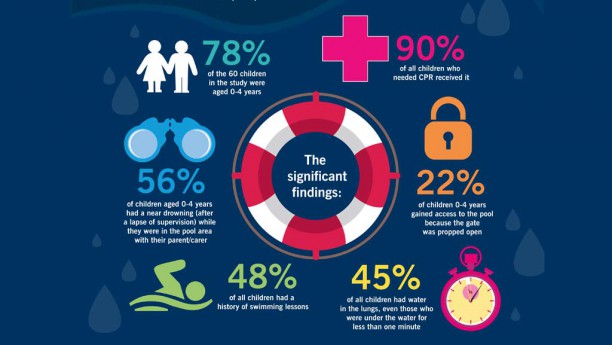Hanging out at the pool is beacons of fun during the warmer weather months. When combining water, electricity and excitement however, you get risk! Every pool owner and manager is responsible for maintaining safe environments for their guests.
What you will learn:
- What makes fences so important
- Risks of drain entrapment
- Electrical safety at the pool
- Pool accidents and insurance
Risks at the Pool
From infections to entrapments, there are risk factors at the pool that are important to address. With careful planning and a pro-active approach, we can all help prevent accidents on those beautiful days at the pool... because they do happen!
The U.S. Consumer Product Safety Commission's 2016 report found that almost 5,000 people receive emergency care every year due to injuries suffered in pools or spas.
This infographic by Pool Safely details the CPSC's report on pool-related accidents.
 Source: Pool Safely
Source: Pool Safely
Experts say these accidents can be mitigated by implementing and maintaining certain safety measures... so here we are!
This safety checklist can help pool owners and managers keep their pool safe against the most common factors of injury:
Fence it in
According to the CDC, there are thousands of fatal pool drownings every year. Almost 25% of these cases involve children. Of the children who nearly drowned in a backyard pool, 22% gained access through an open gate. Keeping pools off-limits outside of supervised hours is key to preventing injuries or even fatalities.
Since gates can be opened, or left open, consider building fences or barriers to keep kids out of the pool. Fences should be at least four feet high and should surround the pool on all sides, to keep children from climbing over.
You can even consider installing a door alarm from the house to the pool area, or invest in an automatic pool cover to eliminate the risk entirely!
Avoid the drain
Pool drain suctions are stronger than most people think. If you get too close to a drain with a non-compliant cover, the suction can get a hold of jewelry, swimwear, or hair. This can result in drain entrapment or entanglement, which can lead to injuries in both kids and adults. After all, ensuring that your pool has safe drain covers is the law!
The Virginia Graeme Baker Pool and Spa Safety Act (VGBA) is a federal law requiring pools and spas to maintain safer compliant drain covers and avoid entrapment hazards. 
Electrical safety
Modern pools are equipped with Ground Fault Circuit Interruption (GFCI) protections. In short, a GFCI is a circuit breaker designed to shut off electrical power when a ground fault occurs, preventing fatal electrocution in the pool.
While highly effective, these devices must be tested on a recurring basis to ensure proper functionality. Pool managers and owners should hire qualified electricians who can guarantee that your pool and its surrounding area are electrically safe and compliant.
Maintain pool hygiene
According to the CDC, there has been a rise in recreational water illnesses (RWIs), including respiratory, skin, ear, eye, and wound infections. Kids and adults can contract RWIs by swallowing, breathing, or even having contact with contaminated pool water.
While chlorine and other disinfectants are designed to kill bacteria found in pools, they're not instant germ killers. To keep the water clean and your guests safe, pool managers and owners should:
- Test the water to ensure regular free chlorine (1-3 mg/L) and pH levels (7.2-7.8)
- Encourage showers before and after swimming
- Warn against swallowing pool water
- Stop the kids from urinating in the pool!
Supervise at all times
One of the most important pool safety factors is supervision. No child should be left unattended. Adults and chaperones who monitor children at pools should be able to swim, perform CPR, and should always have a phone in case of emergencies.
 Source: NSW Study, Splash Magazine
Source: NSW Study, Splash Magazine
According to the NSW Study of Drowning and Near Drowning in Children, the critical age groups where unsupervised drowning is most likely (0-4 years and 5-10 years) are being left unattended at the pool. Don't leave kids unattended at the pool!
Insurance Talk: Are pool accidents covered?
Your homeowners or general liability policy can cover your swimming pool under specific circumstances. For example, if damage to the pool is caused by covered perils, your homeowners policy will cover your losses. Covered perils include fire, smoke, lightning, windstorms, hails, theft, explosion, falling objects, etc.
In addition to physical damages, injuries sustained by pool guests can also be covered by a general liability policy, if you have one in place. Got questions? Talk to an advisor!
Make Water Safety a Priority
From weekend backyard barbeques and pool parties to annual vacations, every pool and warm summer day holds the possibility of new, fun summer experiences. It’s really important that pool owners and managers never overlook swimming safety precautions. Planning ahead for family or guest safety helps everyone enjoy the fun!




